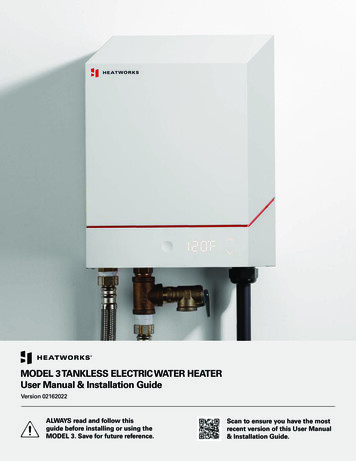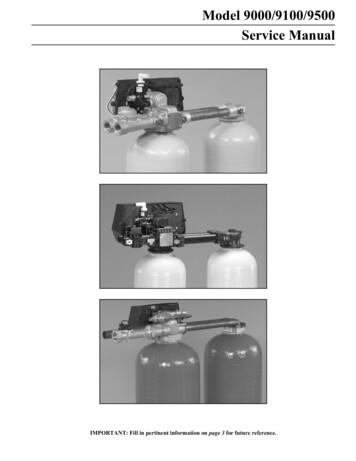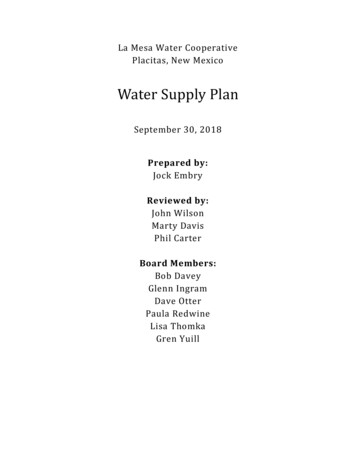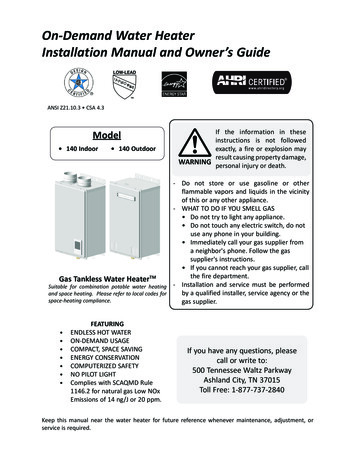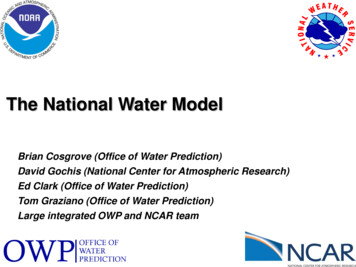
Transcription
The National Water ModelBrian Cosgrove (Office of Water Prediction)David Gochis (National Center for Atmospheric Research)Ed Clark (Office of Water Prediction)Tom Graziano (Office of Water Prediction)Large integrated OWP and NCAR team
National Water Model Version 1.0 NWM Implementation on WCOSS– Strong OWP/NCAR/NCEP partnership– Science briefing July 29th, 30-day IT evaluation ends August 5th,implementation planned for August 16th Utilizes community-based WRF-Hydro framework supportedby NCAR Foundation for sustained growth in nationally consistentoperational hydrologic forecasting capability Goals for NWM V1.0– Provide forecast streamflow guidance for underserved locations– Produce spatially continuous national estimates of hydrologicstates (soil moisture, snow pack, etc.)– Implement a modeling architecture that permits rapid infusion ofnew data and science, and allows for geointelligence linkages2
NWM Operational ConfigurationRunning Continuously on WCOSS since May 9thAnalysis & yDaily at 06ZDaily Ens (16 mem)0-15 hours0-10 days0-30 daysCycling FrequencyHourlyForecast Duration- 3 hrsForecast Latency (latency of external forcing data accounts for most of delay)1 hour1 hour 45 mins6 hours19 hoursDownscaled HRRR/RAPblendDownscaled GFSDownscaled & biascorrected CFS1km/250m/NHDPlusReach1 km/NHDPlus ReachMeteorological ForcingMRMS blend/HRRR/RAP bkgnd.Spatial Discretization & ssimilation of USGS ObsReservoirs (1260 water bodies parameterized with level pool scheme)3
NWM V1.0 Output Hydrologic Output– River channel discharge and velocity at2.7 million river reaches– Reservoir inflow, outflow, elevation– Ponded water depth and depth tosaturation (250 m CONUS grid) Land Surface Output– 1km CONUS grid– Soil and snow pack states– Energy and water fluxesCurrent NWS AHPS points (red)NWM output points (blue) Direct-output and derived products (e.g.stream flow anomalies)4NWM 1km LSM DomainCurrent NWS River Forecast Points (circles)Overlaid with NWM Stream Reaches 4
NWM Evaluation Several groups are currently involved in NWM evaluation– River Forecast Centers (RFCs) Initially via NWM Output Assessment Team (NOAT) Expansion to all 12 CONUS RFCs complete– NCEP Weather Prediction Center (FFAIR experiment) Environmental Modeling Center– NWS Eastern Region HQ– Private company (Worldwinds Inc.)– Office of Water Prediction CUAHSI via ongoing Innovator’s Program NWM Implementation Project NWM Initial Operational Evaluation Project– NCAR NWM Implementation Team Groups evaluating NWM output will expand over time– OWP Water Resource Evaluation Service (WRES)– NWS Weather Forecast Offices (WFOs)– NWS Western Region HQ5
VLAB Iterative RFC Evaluation Feedback LoopRFC IdentifiesissueCreates VLABtracking ticketNOAT ProcessLeverages VLABRelevantevaluationmembers notifiedFeedbackprovided to RFCIssue Categorization Underlying dataset issue Model bias Missing post processedRFC output point Success storyOWP and NCARexamine issue6
Initial Feedback Initial feedback from evaluators has been very promising Areas of strength– RFCs: Excitement over initial capabilities provided by model, and prospects forfuture growth Flash Flooding: “That's an excellent example not sure if you would get better than this” River Forecast: “Fine temporal resolution and robust model physics appear to capturehydrologic details in impressive ways” Value in use of NWM precipitation forcing in poorly gauged areas Areas for future development– RFCS: Various categories of feedback, which will be addressed via tight RFC-OWPpartnership Reservoirs and water diversions not fully represented Trans-border and stream loop connection issues Model bias: “ forecasts were impacted by questionable model states ” (i.e.,QPE/QPF/parameters)– WPC: Feedback highlighted isolated, overly quick water infiltration– General: Improved visualization capabilities will enhance usability of output Thus far, overall assessment is this: While aspects of the model need to beimproved, it provides valuable initial capabilities and a foundation for longterm growth in operational hydrology7
NWM V1.0 Output Dissemination Visualization and data dissemination key to success,area of active developmentThree-pronged output dissemination strategyOWP IDP-hosted website-based r)– Current Static soil, streamflow images w/animation (streamorder 3)CHPS– Near-Term Progressive disclosure to enable access to fullresolution of NWM analysis output (stream order 1) Point and click forecast hydrographs for any streamreach, ESRI geodata server Subsetted data feed to River Forecast Centers– Community Hydrologic Prediction System– WFO access via remote-login– Streamflow at river reaches– Gridded soil moisture output, precipitation forcing File dissemination via NOAA NOMADS server (fullset of output variables,http://para.nomads.ncep.noaa.gov/)Web Tools8
NWM: Improved Hydrologic Situational AwarenessUSGS Observed Streamflow Anomalies (dots)and NWM Analysis Streamflow Anomalies (lines)9
Initial Retrospective NWM CONUS Evaluations: StreamflowAverage Daily Streamflow Correlation Over Gages II Unregulated BasinsSimulation With NLDAS2 Forcing, Final Parameters, No Data Assimilation (Oct 2014 - Feb 2016)Correlation: 73% of basins havecorrelation 0.6 Correlation highdespite noassimilation ofstream gage data10
Initial Retrospective NWM CONUS Evaluations: StreamflowRegional Breakouts of Big River Flows:Promising initial results: Simulatedflows closely resemble actual flowwhere flow is unregulated11
National Water Model V1.0 CONUS-Wide Forecast Evaluation Initial nationwide evaluation efforts are underway usingreal-time NWM forecast output from WCOSS– Complements retrospective verification efforts– Assessment representative of future focus of OWP Water ResourceEvaluation Service– Provides assessment of NWM forecast skill– Provides an objective set of measures upon which to base future modelupgrades Findings echo feedback from RFCs: though there are areas toaddress, NWM V1.0 provides valuable and actionable initial skill12
National Water Model Forecast Evaluation: Short Range Forecasts Short Range Prediction Goal:Provide effective guidance forfloods and flash floods Assess skill of forecast peak flowamount and timing Based on 40 days of NWMforecasts from WCOSS versus 1000 USGS Gauges II unregulatedstations, May-June 2016Preliminary Findings Errors in peak flow amount centeraround 0, and are relatively small(i.e., 5 cms) Median errors in peak flow timingare generally under 2 hoursPre-operational Short Range (0-15 hrs) Verification13
National Water Model Forecast Evaluation: Medium Range Forecasts Verification of medium-rangeforecasts ongoing As expected, NWM version 1.0exhibits areas of varyingstreamflow forecast performance Strength in hydro-blind areas andphysical process representationMisses eventdue to QPFBumping River Near Nile, WANWM mediumComparable toValuable New Capabilityexisting NWS AHPS(catches diurnal snowmelt cycle)Pre-operational Medium Range (0-10 days) Verification14
National Water Model Forecast Evaluation: Long Range Forecasts Preliminary Findings:–Regional breakout by RFC reveals consistency of underlying dry bias–SERFC is an outlier with a positive forecast bias, consistent with high bias in that region in retrospective simulation–All regional median 30 day total volume inflow errors are less than 3k ac-ft for USGS reference basins, much lessthan the mean inflow.–WGRFC exhibits most negative bias likely due to underestimate of flooding rains in CFSPre-operational Long Range Ensemble (0-30 days) Verification15
National Water Model Forcing EvaluationOngoing Work:Assessment of how much errors in QPF contribute to errors in NWM streamflowSample type of plot that will be used to examine key relationshipbetween precipitation forcing and NWM streamflow forecast accuracy16
NWM Forecasts: West Virginia Floods on June 23, 2016NWM AnalysisValid 05Z 6/23NWM 10 hr FcstValid 15Z 6/23NWM 5hr FcstValid 10Z 6/23NWM 15 hr FcstValid 20Z 6/23NWM flow anomalies show transition from much below normal to high flow conditions over17course of 15-hour NWM short range forecast. General pattern matches local storm reports.
Crossings Mall, Elkview, WVHydro-Blind (no AHPS river forecasts, no USGS gauge)500 people trapped at Crossings Mall20:00Z 6/2318
NWM Forecasts: West Virginia Floods on June 23, 2016NWM Streamflow (CFS) at Elkview West Virginia2500.00Bridge Collapses2000.001500.00NWM Analysis1000.0005Z NWM SRF500.000.00NWM forecast forced with HRRR showed event signal 12 hours in advance.However, there was large run-to-run variability due to QPF forcing.19
Event OverviewBlanco River FloodingMay 23-24 2015“Hydro-rich” area(gauged with AHPS point)Cyprus CreekWilson CreekBasin Size 1130 km2SEVERE FLOODING IN WIMBERLEY.RESIDENTS STRANDED ON ROOFTOPS5/24 04ZBlanco River17 kmRM 1623 CLOSED DUE TO FLOODING5/23 23ZFISCHER STORE ROAD BRIDGE OVERTHE BLANCO RIVER HAS BEENDESTROYED5/24 08ZSEVERE FLOODING IN WIMBERLEY.RESIDENTS STRANDED ON ROOFTOPS5/24 04ZI-35 NORTHBOUND AND SOUTHBOUNDCLOSED DUE TO BLANCO RIVER FLOODING.POSSIBLY 3 CARS IN THE WATER.5/24 09Z Heavy rain fell in the headwaters of the Texas Blanco River Basin over 4-6 hours Blanco River at Wimberley rose from near 5 feet at 9pm to near 41 feet by 1am, rising 5 ftevery 15 minutes from 10:45pm to 11:45pm.20
Existing NWS Hydrologic Tool: Watches/Warnings NWS did a good job highlighting general threat of flooding Products included flash flood watches, warnings and emergencies along withriver flood warnings Several hours of lead time were granted by warnings Increase in geographic specificity of watches and warnings would havebeen beneficial21
National Water Model Forecast EvaluationBlanco River at Wimberley Texas (08171000)Short-Range NWM Forecasts, May 2015 Challenging, localized event5/23 15Z Short Range Forecast150,000 Flooding reported at 04Z, residentson rooftops5/24 00Z Short Range ForecastAnalysis and AssimilationUSGS Observationsstreamflow(cfs)streamflow (cfs)*NWS River Flood Warn (minor)Record 33’100,000 NWM forced with HRRR forecastsand MRMS observations Key highlights of NWM outputMajor 26’50,000Moderate 17’Minor 12’Action 10’05/23 18Z*5/24 00Z5/24 06Z5/24 12Z– Analysis w/DA tracks flood peaktiming and magnitude very well– NWM forecasts, used tocomplement existing guidance,would have provided several hoursof lead time, indicating potentialfor significant flooding at locallevel5/24 18ZHRRR-driven NWM provided 12 hour lead time for this event22
NWM V1.0: Forward-Looking Opportunities NWM outputs nationally consistent forecasts of several “non-standard”but powerful hydrologic fields that will offer additional insight toforecasters and emergency responders, carrying us beyond streamflow A strong focus of future efforts will be on extracting and highlightingactionable information from these fields23
NWM V1.0: Forward-Looking Non-Traditional OutputStreamflow VelocityMay 23, 2016Depth of local ponded water: Valid 12Z April 18th, 2016 Depth of ponded water analyses and forecasts, insight into non-channelized flash flooding (right) Streamflow Velocity analyses and forecasts, public safety and engineering applications (left)24
NWM V1.0: Forward-Looking Non-Traditional OutputDepth to soil saturation: May 24th 2015 NWM Depth-To-Saturation analyses and forecasts Added insight into flooding potential Inundation mapping capabilities driven with NWM output under development25
SummaryNational Water Model V1.0 scheduled for August 16th implementation Status– Science briefing July 29th, 30-day IT test ends August 5th– Visualization tool enhancement in progress Evaluation efforts ongoing, including multiple River Forecast Centers –feedback to date indicates NWM guidance valuable for operations NWM will provide complementary hydrologic guidance at currentforecast locations and significantly expand guidance coverage and type Future enhancements planned and tied to OWP strategic roadmap, butfrom the start NWM V1.0 establishes foundation for sustainedimprovement in water prediction and first ever nationally consistentoperational hydrologic forecasting capability26
Seamless Simulation of Nation’s Hydrologic System27
ADDITIONAL MATERIAL28
2.5 ton truckFort Hood, Texas Flash Flooding Heavy rain led to flash flooding of small Owl Creek the morning of June 2nd, 2016. Nine soldiers drowned after their 2.5 ton truck was swept off a low water crossing on base 2 inches of rain fell over basinNot a lightweight truck 2 hours(image for illustration of flow only not Owl Creek)29(image for illustration of flow only not Owl Creek)
Fort Hood Flash Flooding: NWS ServicesOverall NWS service provision for this event Underserved/Hydro-blind areaNWS Flash Flood Watch During Event Nearest NWS river forecast pointand USGS gauge 25km fromwhere flooding occurred Flash flood watch active forbroad area “FLASH FLOOD WATCHCONTINUES FOR A PORTION OFNORTH CENTRAL TEXAS.MANY AREAS HAVE ALREADYRECEIVED HEAVY RAINFALLOVER THE LAST WEEK ANDADDITIONAL RAINFALL IS LIKELYTO CAUSE FLOODING”30
Fort Hood Flash Flooding: NWM Short-Range ForecastsFort Hood Transport Washed off 007Z SRF2500.0008Z SRF09Z SRF2000.0010Z SRF1500.0011Z SRF1000.0012Z SRF13Z SRF500.000.0008Z 09Z 10Z 11Z 12Z 13Z 14Z 15Z 16Z 17Z 18Z 19Z 20Z 21Z 22Z 23ZJune 2nd 2016 The NWM short range forecast detects the basic event signal 9 hours in advanceSeven hours in advance, the model captures the timing extremely wellTaken together, they give a forecaster useful insight into this severe, localized eventCould enable specific, localized actions to prevent loss of life and propertyTiming varied at medium range (not shown), but basic signal appeared 4-5 days out31
The National Water Model . David Gochis (National Center for Atmospheric Research) Ed Clark (Office of Water Prediction) Tom Graziano (Office of Water Prediction) Large integrated OWP and NCAR team . National Water Model Version 1.0 . new data and science, and allows for geointelligence linkages 2 .






